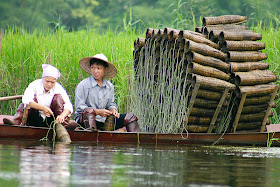To begin with, fish provides a steady source of food, more reliable than vegetable gathering or random foraging or hunting (‘hunting’, further down the list, refers to systematic practices, which I’ll deal with in time). Early civilizations were at the mercy of the environment – a consistent, plentiful supply of food meant stronger, healthier societies. In D&D terms, this means a higher average hit points per die (increased constitution bonuses) and greater strength. Furthermore, the use of tools in order to fish increases dexterity for the whole population, as generation after generation learns from infancy the practice of hurling a barbed spear to obtain food. The barbed spear itself is an improvement over the club, as it is a superior short range missile weapon.
There are several methods of fishing; early societies would develop the above mentioned spearing, or the gathering of seafood by hand – clams, crab, oysters and so on. Hand gathering of abalone or lobsters would imply diving beneath the water, as well as the gathering of pearls for wealth. Hunting for oysters can include the practice of diving to depths up to 30 meters. The members of the culture would thus be very comfortable in water, and would possibly seek to combat land-conscious enemies in that environment.
While hunter/gatherers must move to seek food, fishing cultures may establish permanent settlements. The tendency is to build habitats near or onto the water, making food gathering more efficient and increasing defence. Homes might include rock dwellings on small islands offshore, dwellings built upon pilings above open water (lakes) or tidal flats (seacoasts).
A moderately greater increase in technology would mean the creation of traps, permanent or semi-permanent structures placed within a river or on a tidal area to gather fish moving past. Elaborate traps may catch unusual species, such as stone fish or eels, increasing the variety of food and possibly the toleration of the inhabitants to poison, say a +1 save against. Fish traps would also teach the method of creating elaborate traps to catch or kill humans, making such cultures more dangerous to approach.

Netting would allow for the use of nets as combat tools and a greatly increased supply of food (and thus a greater number of members in the community). The first villages, incidentally, were not dependent on pottery as suggested by Civ IV, but in fact occurred around freshwater or tidal sources where food was plentiful and good gathering technologies available.
The development of a boat by a culture allows for greater range of movement, a wider knowledge of the region and more contact with other groups, who may be themselves fishing cultures or may only have access to the water, or potentially obscure cultures living under the sea. This greater knowledge would increase the willingness of the fishing culture to accept visitors, be less fearful of strangers and be more able to identify local places the party may be seeking.
Pure fishing cultures began as early as 40,000 years ago. Unusual features include the occurrence of shell middens (piles of discarded seafood shells, particularly clam/oyster) and fishbone piles.
Greater comprehension of fish migration patterns would encourage exploration. Fish oil aids in food preservation and in the creation of a light source at night. Cultures around reefs would include corals as wealth.
That is a brief overview. I hope it gets the ball rolling.
Interesting; this excites the anthropology student in me.
ReplyDeleteI'm looking forward to seeing how this series develops, as I've been starting to think along the same lines while reading Salt: A World History, which touches on similar ideas.
This is excellent.
ReplyDelete